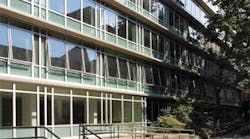Relying on your building’s HVAC system may guarantee the conditions in your building remain constant, but introducing high-performance operable windows can provide the same benefit – and more.
Newer models have made great advances that place them on par with other high-performance options. “Advances in weather stripping and hardware design enable today’s operable windows to perform at much higher levels than their predecessors,” says Ken Brenden, technical services manager for the American Architectural Manufacturers Association (AAMA). “In addition, these products can offer enhanced protection from severe wind-driven rain events, impact resistance from hurricanes, tornados, humans, and forced entry resistance.”
Ease of cleaning is another benefit, according to Brenden. “Certain operating window types permit cleaning of the exterior glass surface from the interior of the building.”
Breezy Benefits
Perhaps the greatest benefit that operable windows provide is ventilation, which can have a positive impact on your HVAC budget. “In many parts of the U.S., natural ventilation offers a seasonal opportunity for air conditioning energy savings if included as part of the HVAC design, balancing, and operating plan,” Brenden says.
This benefit is recognized as being both energy efficient and good for a building’s indoor air quality. “Recognizing their sustainable design benefits, the USGBC LEED Rating System awards points for operable windows in the Ventilation Effectiveness and Controllability of Systems credit categories,” Brenden explains.
“Operable windows can be a part of an effective natural ventilation strategy, when applied using the recommendations in the Carbon Trust Good Practices Guide 237 and ASHRAE 62.1-2004,” adds Steve Fronek, vice president of technical services for Wausau Window and Wall Systems. “In IEQ Credit 6.2 Controllability of Systems – Thermal Comfort, occupant-controlled operable windows may be used in lieu of comfort controls for areas nearby, as outlined in ASHRAE 62.1-2004.”
Smart Systems Advances in operable window technology will squash the fear you have about employees opening the windows while your HVAC system is trying to heat or cool the building.
“Operable windows can be equipped with motorized mechanical operators, which allow the opening and closing modes to be controlled,” says Brenden. “They can also be designed to activate automatically for smoke evacuation.”
You also have the option of providing your HVAC system with window status feedback. “The interface between operable windows and mechanical systems can be as basic as a switch that automatically turns off local HVAC components when windows are open,” Fronek says. “Like any building system, windows and curtainwalls in nearly-zero-energy buildings (ZEBs) are subject to inherent trade-offs, specifically between thermal performance, natural daylighting, ventilation, costs, and appearance. In a traditional product selection approach, static energy-related parameters – such as U-factor, solar heat gain coefficient (SHGC), and visible light transmission (VT) – are used to set performance specifications. These often will not be sufficient with assessing active ZEB system interactions.”
Using between-glass blinds, electrochromic dynamic glazing, and automatically controlled shades make VT and SHGC values a function of your BMS control algorithms. “BMS-controlled mechanical ventilation is employed as a strategy in some ZEBs to provide increased outdoor air flow or reject waste heat, either through louvers, operable vents in the windows or curtainwall system, or as part of a rain-screen facade,” Fronek explains.
Retrofit Ready
Operable windows can sometimes be installed more easily in retrofits than fixed windows. “In some cases they are actually preferred due to the fact that anchor fasteners can be concealed between the sash and the frame, eliminating the need for special anchor clips,” Brenden says.
Operable windows have a slightly higher initial cost and require periodic maintenance to keep the weather-stripping, hinges, and locking mechanisms performing properly. However, performance is comparable to that of fixed windows. "No performance trade-offs are necessary,” Fronek says. “Modern high-performance AAMA AW Class operable architectural windows are airtight, durable, lifecycle tested to 4,000 operating cycles, and resistant to commonly encountered misuse by occupants.”
Kylie Wroblaski ([email protected]) is associate editor of BUILDINGS.


